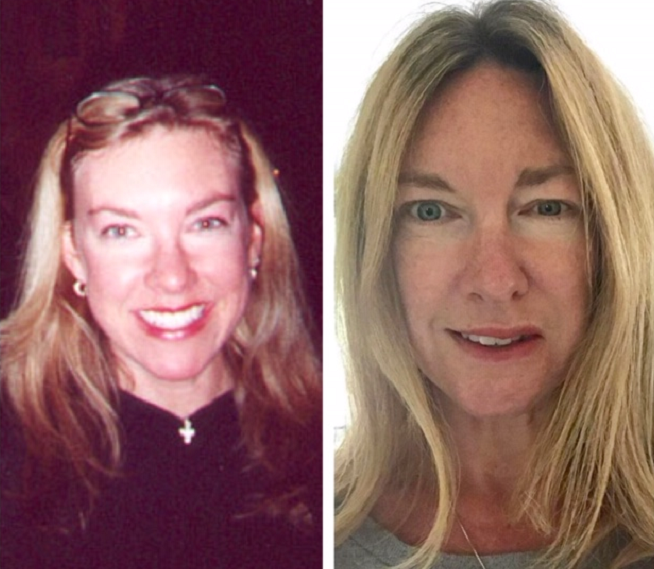I still miss my smile—and being able to blow up balloons.
Every few months I have a recurring dream: I wake up, feel the left side of my face back to normal, go to the mirror, and see that I look like myself again—the version of me I knew for 35 years. I can’t stop smiling at my reflection. In that dream I feel free and elated.
Then, I wake up and remember my diagnosis: permanent facial nerve damage from Lyme disease during pregnancy.
The day after my first baby shower, I woke up immediately knowing something was wrong. The pain I had been feeling around my ear and jaw for three weeks had partially subsided, but my left eye felt dry, there was copious drool on my cheek, and I felt dizzy.
What I saw in the bathroom mirror shocked and terrified me. My left eye was wide open and much bigger than my right eye. My left eyebrow was frozen in place. The left side of my mouth drooped lifelessly. I couldn’t move it at all. I watched myself try to blink, but only the right eye worked.
Thinking I may have suffered a stroke overnight, I went to the emergency room.
The ER doctor told me it wasn’t a stroke—instead I had idiopathic Bell’s palsy. For the next few months, I had to tape my eye shut at night and wear an eye patch during the day. I was tested for Lyme, but it came back negative the first time. My main sources of comfort and healing were prenatal yoga and acupuncture sessions.
My family members were bewildered at how quickly my health deteriorated at the end of my third trimester. I was being monitored for signs of preeclampsia, a liver toxicity issue which can occur near the end of pregnancy. One of the complications of Lyme is liver inflammation and infection from Lyme bacteria.
On the day my son Alec was born, after 36 hours of labor and an emergency C-section, I flatlined on the operating table. I learned this later from my husband—I had no memory of being unconscious, then coming back. I remember feeling immense gratitude, relief, and joy when I saw my healthy 8.4-pound baby for the first time. Fortunately, I was able to breastfeed and care for him in the following months.
With a four-month-old baby, I experienced unrelenting pain in my back, neck, and joints. I suspected it wasn’t caused by breastfeeding. I had frequent heart palpitations. When I saw my primary care doctor he retested me for Lyme. I had developed a heart block, and he suspected damage to my central nervous system. This time, the test came back positive. After two rounds of strong antibiotics, most of my symptoms subsided.
I had hope for my damaged cranial nerves: VII (facial innervation nerve), XII (hypoglossal nerve), and X (vagus nerve). However, a further visit to a neurologist confirmed my worst fears: my case was too severe to expect complete recovery. One side of my face would never look or feel the same again.
What I miss most is being able to fully express emotions with my mouth and eyes. I am naturally expressive and animated. I always had a wide, impish grin and two eyebrows that moved up and down, or drew in toward the middle, expressing surprise, delight, dismay, or concern. People often told me I could speak with my eyes. Now, my left eye moves in unexpected ways when I talk, sometimes twitching or closing when I don’t want it to. When I smile, one eye nearly closes, and sometimes it looks like I’m winking when I’m not. The neurological link between my emotions and one half of my facial muscles isn’t functional—and this disconnect profoundly impacts how I feel.
The most difficult aspect of any permanent facial disfigurement is the psychological challenge of looking different from everyone else. Anxiety, depression, and low self-esteem are pervasive in the lives of long-term Bell’s palsy sufferers, cancer survivors, burn victims, and anyone who has experienced facial trauma.
There is tremendous pressure in our society to present a beautiful appearance to the outside world. The importance of external beauty has been greatly exaggerated in the age of social media, yet platforms like Instagram and Facebook are also being used to build awareness around self-acceptance and success that’s not based on how we look, but instead on how we feel and how we’re benefiting the world.
I felt that Lyme had destroyed my external beauty and usefulness. After 12 years with this condition, I still work on rebuilding my confidence. Initially, I had severe social anxiety and didn’t like to leave my apartment. I’ve made great strides managing the residual physical pain, including occasional migraines and frequent muscle tension. The psychosocial residuals present a greater obstacle, yet I’ve embraced a tender courage I never knew I possessed.
My experience with Lyme, and the nerve damage that followed, left with me three invaluable life lessons:
1. Vulnerability is True Beauty
Everyone can choose to be authentic and vulnerable, yet some of us need a powerful nudge in that direction.
My newfound vulnerability made me more sensitive to the feelings of others. I had to stop hiding behind the façade of appearance. I realized that appearance isn’t what connects us as humans. We begin to realize our commonality and interconnectedness when we let go of what we see on the outside, embracing instead what we feel on the inside. My subjective sense of how I appeared changed, thus changing my experience of connection. I started relating from a place of open authenticity, because I felt I had no choice.
Now, when I see people suffering from loss or life-altering illness, what I can offer is more like empathy and less like sympathy. On my best days, I source from within myself a universal human beauty and dignity no injury can touch, helping others access this quality within themselves.
2. The Truth of Impermanence will Set us Free
Illness and injury call our attention to the fragility of our bodily form. Each physical setback is like a mini-death of the body, which we know to be mortal. Impermanence is a foundational principle of reality, and once we understand what impermanence truly means, we can experience life more fully.
“When you open yourself to the continually changing, impermanent, dynamic nature of your own being and of reality, you increase your capacity to love and care about other people and your capacity to not be afraid. You’re able to keep your eyes open, your heart open, and your mind open.” ~ Pema Chödrön, Practicing Peace in Times of War
Facing our body’s impermanence establishes us in a more stable identity—the bedrock of the true “Self”—which transcends ego and appearance.
3. Our True Identity is Changeless
From birth, we begin building our sense of identity from our relationships to other humans. Rediscovering who we are beyond form and appearance is an advanced undertaking. Our true identity comes not from others’ reactions to and perceived opinions of us, but from our individual and collective being. The yogic teacher Ram Dass speaks and writes of awakening from separateness into being: “Our work is to extricate ourselves from having to look at who we are with each other as egos, rather than as souls.”
An essential part of healing is connecting with our true identity, beyond illness. My most effective healing tools have been yoga and meditation. In these I discovered the unchanging, secure identity I share with all people. It’s the place I come back to when showing my face feels scary. Practicing yoga asana restored confidence in my body, connecting me to its deeper wisdom and strength. Being present with nerve and muscle sensations taught me to practice conscious embodiment. I can know how I’m feeling moment to moment, without identifying with or needing to change the experience.
Practicing and teaching yoga, I’ve connected with others recovering from Lyme, cancer, crippling accidents, and debilitating autoimmune conditions. We’ve empowered each other to recognize our true identity and leverage our inherent resilience.
As much as I would love to wake up feeling and looking like I did those 12 long years ago, I recognize that’s not possible for anyone, under any conditions or circumstances.
So I’m embracing my present condition, knowing it’s temporary, and smiling from the inside.
~












Read 14 comments and reply